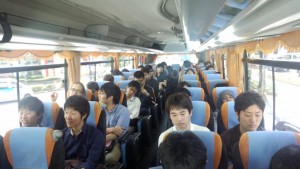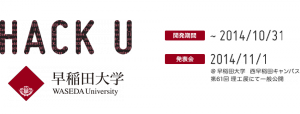Takao Okubo, Yoshio Kakizaki, Yoshinori Kobashi, Hironori Washizaki, Shinpei Ogata, Haruhiko Kaiya and Nobukazu Yoshioka, “Security and Privacy Behavior Definition for Behavior Driven Development,” Proceedings of the 15th International Conference of Product Focused Software Development and Process Improvement (Profes 2014), Short Paper, Helsinki, Finland, 10-12 December 2014. (to appear)
Comparative Study on Programmable Robots as Programming Educational Tools, accepted at ACE 2015 (CORE Rank Australasian, originally Rank B at ERA2010).
Shohei Yamazaki, Kazunori Sakamoto, Kiyoshi Honda, Hironori Washizaki, Yoshiaki Fukazawa, “Comparative Study on Programmable Robots as Programming Educational Tools,” Proceedings of the 17th Australasian Computing Education Conference (ACE 2015), Sydney, Australia Tuesday 27th – Friday 30th January 2015. (to appear)
Computational Thinking skills are basic and important to manipulate computers. Currently, several systems exist to provide a effective way to learn programming that use computers, smartphones, tablets, or programmable robots. Although studies have reported improved programming skills and motivation to learn programming using an on-screen application or a programmable robot, the benefits of these tools have not been directly compared. To resolve this issue, especially with regard to motivation to learn programming and impression of programming, we conducted a large-scale comparative experiment involving 236 middle and high school students to evaluate the effects of a game-based educational application and programmable robots on learning programming. We then compared the effects of a game-based educational application with and without programmable robots on learning programming. We found that employing programmable robots on learning programming did not always have an improvement on students.
FOSE2014にて2件の共著: 重要意思決定キャンバス、OSSの不具合修正曲線に基づく残存未修正不具合数予測
横田真人、雨谷幸郎、井出昌浩、鷲崎弘宜、”システム企画における最適な意思決定のための重要意思決定キャンバスの提案”、ショートペーパ、日本ソフトウェア科学会 第21回 ソフトウェア工学の基礎ワークショップ FOSE 2014 in 霧島、霧島国際ホテル、2014年12月11日(木) – 13日(土)
藤野啓輔、伊原彰紀、本田澄、鷲崎弘宜、松本健一、”OSSの不具合修正曲線に基づく残存未修正不具合数の予測の試み”、ショートペーパ、日本ソフトウェア科学会 第21回 ソフトウェア工学の基礎ワークショップ FOSE 2014 in 霧島、霧島国際ホテル、2014年12月11日(木) – 13日(土)
Continuous Product-Focused Project Monitoring with Trend Patterns and GQM, accepted at QuASoC 2014.
Hidenori Nakai, Kiyoshi Honda, Hironori Washizaki, Yoshiaki Fukazawa, Ken Asoh, Kaz Takahashi, Kentarou Ogawa, Maki Mori, Takashi Hino, Yosuke Hayakawa, Yasuyuki Tanaka, Shinichi Yamada, Daisuke Miyazaki, “Continuous Product-Focused Project Monitoring with Trend Patterns and GQM,” Proceedings of the 2nd International Workshop on Quantitative Approaches to Software Quality, pp.XX-YY, in conjunction with the 21st Asia-Pacific Software Engineering Conference (APSEC 2014), Jeju, Korea, December 1, 2014. (to appear)
It is important for project stakeholders to identify a state of projects and quality of products. Although metrics are useful for identifying them, it is difficult for project stakeholders to select appropriate metrics and determine the purpose of measuring metrics. We propose an approach which defines the measured metrics by GQM method, and supports identifying tendency of projects and products based on Trend Pattern. Additionally, we implement a tool as Jenkins Plugin which visualizes an evaluation results based on GQM method. We perform an experiment with OSS and industrial case study with two software development projects. In our experiment, we can identify the problem and project tendency. In our industrial case study, we can also identify the problem that project contains. As our future work, we adopt our approach and GQM Plugin to software de-velopment project continuously to assess the effectiveness of them in long term.
Joint Summer Seminar Camp was successfully over!
Do open source software projects conduct tests enough? , accepted as short paper at Profes 2014 (CORE Rank B).
Ryohei Takasawa, Kazunori Sakamoto, Akinori Ihara, Hironori Washizaki, Yoshiaki Fukazawa, “Do open source software projects conduct tests enough?,” Proceedings of the 15th International Conference of Product Focused Software Development and Process Improvement (Profes 2014), Short Paper, Helsinki, Finland, 10-12 December 2014. (to appear)
Do open source software projects provide and maintain tests? What metrics are correlated with the test success? This paper answers these questions by executing tests of 452 open source software projects in GitHub and measuring 13 metrics from 77 projects. Only 117 projects passed all test cases. Additionally, the results are correlated with the comment density, public documented API density, and test coverage.
Identifying rationales of strategies by stakeholder relationship analysis to refine and maintain GQM+Strategies models, accepted as full paper at Profes 2014 (CORE Rank B).
Takanobu Kobori, Hironori Washizaki, Yoshiaki Fukazawa, Daisuke Hirabayashi, Katsutoshi Shintani, Yasuko Okazaki, Yasuhiro Kikushima, “Identifying rationales of strategies by stakeholder relationship analysis to refine and maintain GQM+Strategies models,” Proceedings of the 15th International Conference of Product Focused Software Development and Process Improvement (Profes 2014), Helsinki, Finland, 10-12 December 2014. (to appear)
To achieve overall business goals, GQM+Strategies is an approach that aligns the business goals at each level of an organization to strategies and assesses the achievement of goals. Strategies derived from business goals are based on rationales (context factors and assumptions). Because extracting all rationales is an important process in the GQM+Strategies approach, we propose Context-Assumption-Matrix (CAM), which refines the GQM+Strategies model by extracting rationales based on the analysis of the relationships between stakeholders, and the Context Assumption (C/A) definition template to unify the expressive style of contexts and assumptions. To demonstrate the effectiveness of CAM, we conducted an experiment involving 43 students majoring in information sciences at Shimane University in Japan. GQM+Strategies with CAM can extract rationales more efficiently and exhaustively than GQM+Strategies alone. Moreover, when the management policy or the business environment changes, GQM+Strategies with CAM can analyze the rationales and the GQM+Strategies grid easily.
Hack U 早稲田大学 2014 エントリー募集
早稲田大学情報理工・情報通信の学部生、院生の皆さん。プログラミングやデザインを通して、アイデアを形にしてみませんか? ヤフーさんと開発コンテスト Hack U 早稲田大学 2014を開催します。説明会9月25日、開発10月、発表は理工展にて11月1日。開発中は、ヤフーさんのエンジニアの方の技術サポートを適宜受けられます。
Initial Industrial Experience of GQM-based Product-Focused Project Monitoring with Trend Patterns, accepted as Short Paper at APSEC 2014.
Hidenori Nakai, Kiyoshi Honda, Hironori Washizaki, Yoshiaki Fukazawa, Ken Asoh, Kaz Takahashi, Kentarou Ogawa, Maki Mori, Takashi Hino, Yosuke Hayakawa, Yasuyuki Tanaka, Shinichi Yamada, Daisuke Miyazaki, “Initial Industrial Experience of GQM-based Product-Focused Project Monitoring with Trend Patterns,” 21st Asia-Pacific Software Engineering Conference (APSEC 2014), Poster, Jeju, Korea, December 1-4, 2014. (to appear)
It is important for project stakeholders to identify a state of projects and quality of products. Although metrics are useful for identifying them, it is difficult for project stakeholders to select appropriate metrics and determine the purpose of measuring metrics. We propose an approach which defines the measured metrics by GQM method support identifying tendency of projects and products based on Trend Pattern. Additionally, we implement a tool as Jenkins Plugin which visualizes an evalu-ation results based on GQM method. We perform an industrial case study, which object is two software development projects. In our industrial case study, we can identify the tendency of project and product. We also identify the problem that product contains. Therefore if project stakeholders use our approach and tool, then they can identify the problem of project and product.
A Gamified Tool for Motivating Developers to Remove Warnings of Bug Pattern Tools, accepted at IWESEP 2014.
Satoshi Arai, Kazunori Sakamoto, Hironori Washizaki and Yoshiaki Fukazawa, “A Gamified Tool for Motivating Developers to Remove Warnings of Bug Pattern Tools,” 6th International Workshop on Empirical Software Engineering in Practice (IWESEP 2014), Osaka, Japan, November 12-13, 2014. (to appear)
Static analysis tools such as bug pattern tools are useful to detect bugs early in software development. However, existing tools sometimes yield so many warnings that developers tend to ignore such warnings. To deal with this problem, we propose a gamified tool for motivating developers to remove such warnings. Our tool employs the gamification technique that calculates points by counting removed warnings with respect to each developer and each team. The points give developers the feedback and urge them to compete with each other. We confirmed that developers removed about 150% warnings with our tool in comparison with the case where they did not use our tool through an experiment.




